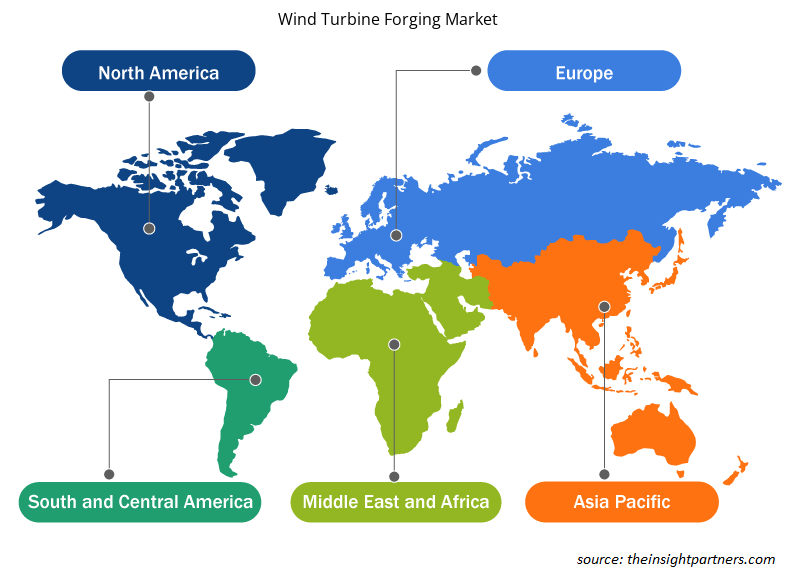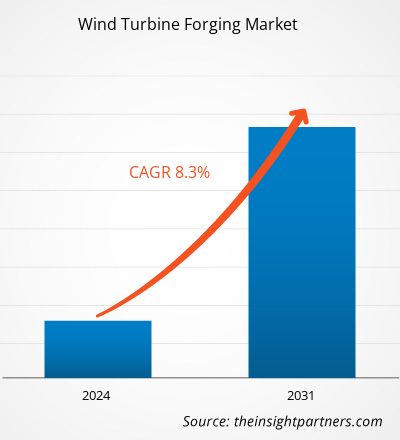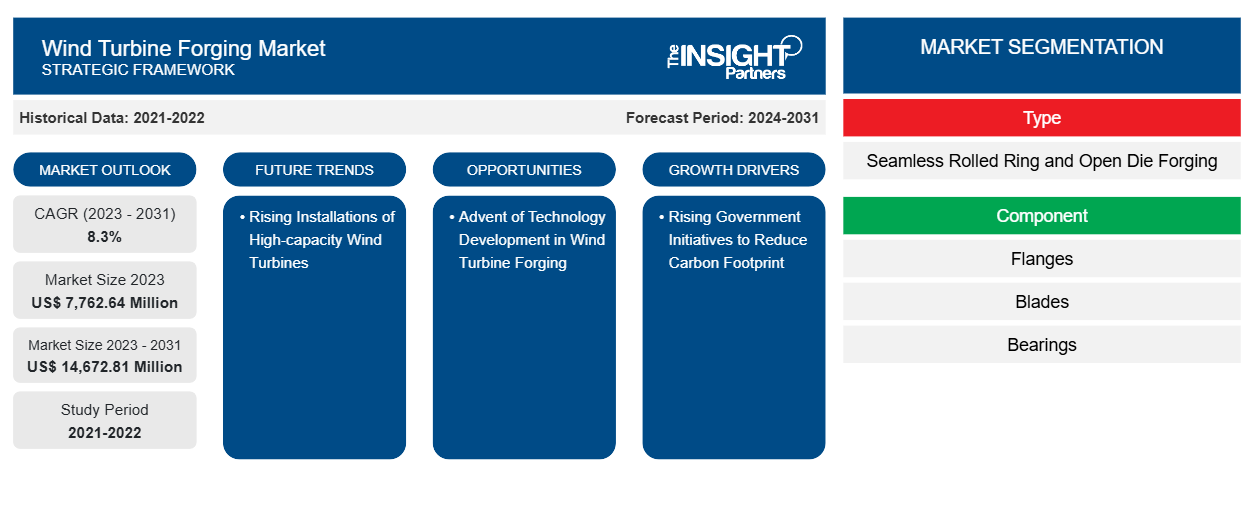Le marché du forgeage des éoliennes devrait atteindre 14 672,81 millions USD d'ici 2031, contre 7 762,64 millions USD en 2023. Le marché devrait enregistrer un TCAC de 8,3 % au cours de la période 2023-2031. L'avènement du développement technologique dans le secteur éolien devrait rester une tendance clé du marché.
Analyse du marché du forgeage des éoliennes
L'écosystème du marché du forgeage des éoliennes comprend Frisa ; Iraeta ; Ulma Forged Solutions ; Celsa Nordic ; Bharat Forge. Ces parties prenantes comprennent les fournisseurs de matières premières, les fabricants de composants et les utilisateurs finaux. Le forgeage des éoliennes est une partie importante du système éolien. Les fournisseurs de matières premières fournissent aux fabricants de produits forgés des matériaux tels que l'acier pour les arbres d'éoliennes ou même le béton pour les tours d'éoliennes. Les fabricants développent ensuite l'arbre principal d'une éolienne, forgé à partir d'acier, qui devient durci et revenu au cours du processus de forgeage. Les tours tubulaires en acier sont fabriquées en 20 à 30 mètres avec des brides à chaque extrémité. FRISA propose des pièces forgées d'éoliennes hautes performances pour les plates-formes d'éoliennes. Les fabricants de composants fournissent ensuite les pièces forgées aux OEM de l'industrie éolienne. La demande croissante de procédés de laminage annulaire avec des diamètres et des sections transversales allant jusqu'à 3 mètres et de pales forgées propulse le marché du forgeage des éoliennes.
Aperçu du marché du forgeage des éoliennes
Les fournisseurs de pièces forgées pour éoliennes comprennent des entreprises telles que Scot Forge Company ; Specialtyring ; Irizar Forge ; Tongyu Heavy Industry Co., Ltd ; et Bortome , qui fournissent des produits forgés aux utilisateurs finaux de l'industrie de l'énergie éolienne. Ces entreprises fournissent des composants essentiels pour le secteur des énergies renouvelables et élargissent constamment leur portefeuille de produits et leur clientèle. La construction croissante de parcs éoliens et d'éoliennes terrestres et offshore devrait stimuler la demande pour le marché mondial du forgeage des éoliennes dans les années à venir.
Personnalisez ce rapport en fonction de vos besoins
Vous bénéficierez d'une personnalisation gratuite de n'importe quel rapport, y compris de certaines parties de ce rapport, d'une analyse au niveau des pays, d'un pack de données Excel, ainsi que d'offres et de remises exceptionnelles pour les start-ups et les universités.
-
Obtenez les principales tendances clés du marché de ce rapport.Cet échantillon GRATUIT comprendra une analyse de données, allant des tendances du marché aux estimations et prévisions.
Facteurs moteurs et opportunités du marché du forgeage des éoliennes
Les initiatives gouvernementales visant à réduire l'empreinte carbone se multiplient pour favoriser le marché
Les mandats et initiatives encourageants du gouvernement soutiennent l'expansion du secteur des énergies propres, qui devrait réduire l'empreinte carbone à l'échelle mondiale. L'accent croissant mis par le gouvernement sur l'établissement d'objectifs visant à atténuer les émissions de carbone des secteurs industriel, résidentiel et commercial d'ici 2030 devrait stimuler la croissance du marché mondial du forgeage des éoliennes. La crise énergétique s'est aggravée en raison de la guerre entre la Russie et l'Ukraine. Cependant, la crise énergétique est positive pour le secteur des énergies renouvelables, car des pays comme l'Italie, le Royaume-Uni et les Pays-Bas orientent leurs investissements et leurs efforts vers les énergies renouvelables telles que l'installation d'éoliennes. L'invasion de l'Ukraine par la Russie a accéléré les investissements dans l'industrie des énergies renouvelables à l'échelle mondiale pour réduire la dépendance aux combustibles fossiles. Les pays ont mis à jour l'objectif en matière d'énergie verte pour répondre aux demandes énergétiques. En outre, la guerre entre la Russie et l'Ukraine a accéléré la croissance du secteur des énergies renouvelables dans les pays asiatiques. La Corée du Sud et le Japon avaient déjà investi dans la technologie de l'hydrogène, et la guerre entre la Russie et l'Ukraine a encore accéléré leurs investissements dans l'industrie des énergies renouvelables. Par conséquent, la demande de solutions de forgeage d'éoliennes a augmenté à mesure que le nombre d'installations d'éoliennes a augmenté à l'échelle mondiale.
Avènement du développement technologique dans le forgeage des éoliennes
L'ingénierie assistée par ordinateur est rapidement mise en œuvre dans le domaine du forgeage, un processus de fabrication qui permet d'obtenir la forme requise d'un élément en appliquant une charge d'impact sur l'élément métallique. L'utilisation de la technologie CAE dans l'industrie du forgeage a considérablement réduit les délais et les erreurs lors de la fabrication des produits, rendant ainsi le processus plus efficace, ce qui devrait offrir de fortes opportunités de croissance pour le marché.
Analyse de segmentation du rapport sur le marché du forgeage des éoliennes
Les segments clés qui ont contribué à l’élaboration de l’analyse du marché du forgeage des éoliennes sont le type et le composant.
- En fonction du type, le marché du forgeage des éoliennes est divisé en anneaux laminés sans soudure etforgeage à matrice ouverte. Le segment du forgeage à matrice ouverte détenait une part de marché plus importante en 2023.
- En fonction de l'application, le marché est segmenté en brides, lames, roulements, engrenages, arbres et autres. Le segment des brides détenait une part importante du marché en 2023.
Analyse des parts de marché du forgeage des éoliennes par géographie
La portée géographique du rapport sur le marché du forgeage d’éoliennes est principalement divisée en cinq régions : Amérique du Nord, Asie-Pacifique, Europe, Moyen-Orient et Afrique, et Amérique du Sud et centrale.
L'Asie-Pacifique est en tête du marché. L'Asie-Pacifique est une région très peuplée du monde entier, avec une demande énergétique plus élevée. La région Asie-Pacifique est extrêmement dépendante des combustibles fossiles pour la production d'énergie, et pour réduire cette dépendance, des pays comme la Chine, l'Inde, le Japon et l'Australie investissent massivement dans des projets d'énergie renouvelable. En outre, la flambée des prix du pétrole brut dans ces régions en raison de la guerre entre la Russie et l'Ukraine a encore aggravé la crise énergétique dans la région. Ainsi, la crise énergétique globale dans la région asiatique a considérablement stimulé les investissements dans les projets d'énergie éolienne et solaire. En fait, la Chine est le plus grand fabricant et détient la plus grande installation de projets d'énergie éolienne au monde. De même, l'Inde et le Japon contribuent également de manière significative au développement du secteur des énergies renouvelables . Ainsi, la crise énergétique a un impact positif significatif sur l'industrie du forgeage des éoliennes, car avec l'augmentation de l'installation d'éoliennes, la demande de composants forgés va également augmenter.
Aperçu régional du marché du forgeage des éoliennes
Les tendances et facteurs régionaux influençant le marché du forgeage des éoliennes tout au long de la période de prévision ont été expliqués en détail par les analystes d’Insight Partners. Cette section traite également des segments et de la géographie du marché du forgeage des éoliennes en Amérique du Nord, en Europe, en Asie-Pacifique, au Moyen-Orient et en Afrique, ainsi qu’en Amérique du Sud et en Amérique centrale.

- Obtenez les données régionales spécifiques au marché du forgeage des éoliennes
Portée du rapport sur le marché du forgeage des éoliennes
| Attribut de rapport | Détails |
|---|---|
| Taille du marché en 2023 | 7 762,64 millions de dollars américains |
| Taille du marché d'ici 2031 | 14 672,81 millions de dollars américains |
| Taux de croissance annuel composé mondial (2023-2031) | 8,3% |
| Données historiques | 2021-2022 |
| Période de prévision | 2024-2031 |
| Segments couverts |
Par type
|
| Régions et pays couverts |
Amérique du Nord
|
| Leaders du marché et profils d'entreprises clés |
|
Densité des acteurs du marché : comprendre son impact sur la dynamique des entreprises
Le marché du forgeage des éoliennes connaît une croissance rapide, tirée par la demande croissante des utilisateurs finaux en raison de facteurs tels que l'évolution des préférences des consommateurs, les avancées technologiques et une plus grande sensibilisation aux avantages du produit. À mesure que la demande augmente, les entreprises élargissent leurs offres, innovent pour répondre aux besoins des consommateurs et capitalisent sur les tendances émergentes, ce qui alimente davantage la croissance du marché.
La densité des acteurs du marché fait référence à la répartition des entreprises ou des sociétés opérant sur un marché ou un secteur particulier. Elle indique le nombre de concurrents (acteurs du marché) présents sur un marché donné par rapport à sa taille ou à sa valeur marchande totale.
Les principales entreprises opérant sur le marché du forgeage des éoliennes sont :
- Scot Forge Co
- Frisa Industrias SA de CV
- Iraeta Energy Equipment Co., Ltd.
- ULMA Forja S Coop
- Celsa Armeringsstal AS
- Bharat Forge Ltd
Avis de non-responsabilité : les sociétés répertoriées ci-dessus ne sont pas classées dans un ordre particulier.

- Obtenez un aperçu des principaux acteurs du marché du forgeage des éoliennes
Actualités et développements récents du marché du forgeage des éoliennes
Le marché du forgeage des éoliennes est évalué en collectant des données qualitatives et quantitatives après des recherches primaires et secondaires, qui comprennent d'importantes publications d'entreprise, des données d'association et des bases de données. Quelques-uns des développements sur le marché du forgeage des éoliennes sont énumérés ci-dessous :
- Les brides du projet éolien offshore Moray West ont été expédiées avec succès depuis Iraeta. Il est entendu que les brides seront utilisées pour le projet éolien offshore Moray West en Écosse, qui utilise des éoliennes SGRE de 14 MW. Iraeta a réalisé les 62 jeux de brides TP et les 30 jeux de brides MPS pour le projet, soit un total de 152 brides. (Source : Iraeta Energy Equipment Co Ltd, communiqué de presse, novembre 2022)
- Bharat Forge commence à fournir des pièces forgées en acier vert , renforçant ainsi l'engagement de l'entreprise à réduire son empreinte carbone. (Source : Bharat Forge, communiqué de presse, décembre 2022)
Rapport sur le marché de la forge des éoliennes : couverture et livrables
Le rapport « Taille et prévisions du marché du forgeage des éoliennes (2021-2031) » fournit une analyse détaillée du marché couvrant les domaines ci-dessous :
- Taille et prévisions du marché du forgeage des éoliennes aux niveaux mondial, régional et national pour tous les segments de marché clés couverts par le champ d'application
- Tendances et dynamiques du marché des éoliennes telles que les moteurs, les contraintes et les opportunités clés
- Analyse PEST et SWOT détaillée
- Analyse du marché du forgeage des éoliennes couvrant les principales tendances du marché, le cadre mondial et régional, les principaux acteurs, les réglementations et les développements récents du marché
- Analyse du paysage industriel et de la concurrence couvrant la concentration du marché, l'analyse de la carte thermique, les principaux acteurs et les développements récents pour le marché du forgeage des éoliennes
- Profils d'entreprise détaillés
- Analyse historique (2 ans), année de base, prévision (7 ans) avec TCAC
- Analyse PEST et SWOT
- Taille du marché Valeur / Volume - Mondial, Régional, Pays
- Industrie et paysage concurrentiel
- Ensemble de données Excel
Rapports récents
Rapports connexes
Témoignages
Raison d'acheter
- Prise de décision éclairée
- Compréhension de la dynamique du marché
- Analyse concurrentielle
- Connaissances clients
- Prévisions de marché
- Atténuation des risques
- Planification stratégique
- Justification des investissements
- Identification des marchés émergents
- Amélioration des stratégies marketing
- Amélioration de l'efficacité opérationnelle
- Alignement sur les tendances réglementaires























 Obtenez un échantillon gratuit pour - Marché du forgeage des éoliennes
Obtenez un échantillon gratuit pour - Marché du forgeage des éoliennes